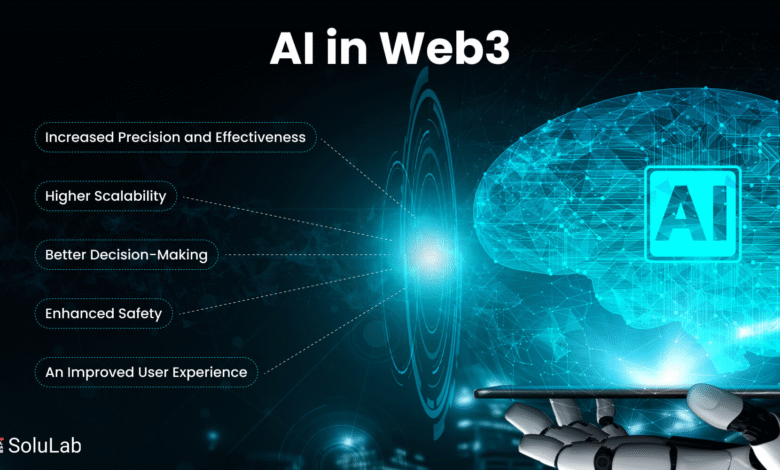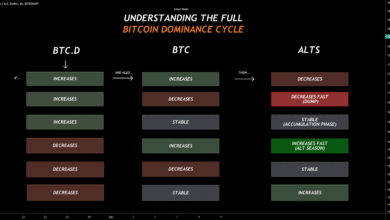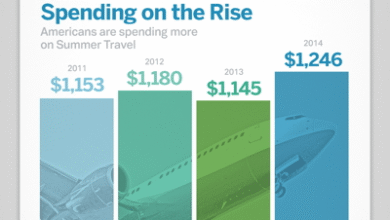AI in Web3: Transforming the Knowledge Coordination Layer

AI in Web3 is rapidly redefining how decentralized networks operate, transforming them into what Openledger’s Ram Kumar calls a “knowledge coordination layer.” As the fusion of artificial intelligence and blockchain continues to gain traction, developers are increasingly drawn to Web3 AI integration for its ability to tackle fresh technical challenges and foster sustainable business models. The shift from traditional decentralized finance (DeFi) projects to AI-centric initiatives highlights a growing recognition of blockchain AI applications and their broader cultural relevance. With Kumar emphasizing the importance of approaching these innovations as research projects, it’s evident that the landscape of decentralized AI challenges is opening up unprecedented opportunities for developers. This convergence not only reimagines the functions of Web3 but also promises to enhance user experiences and engagement across the digital economy.
The intersection of decentralized technologies and artificial intelligence is fostering a new paradigm in the digital ecosystem, often referred to as Web3 AI. This synergy of advanced computing and distributed ledger systems is reshaping how data is managed and utilized, enabling innovative applications that enhance operational efficiency. As more developers pivot towards AI-infused blockchain projects, the quest for novel solutions to ongoing centralized challenges becomes more pronounced. This evolution embodies the principles of knowledge coordination, where data flows seamlessly to facilitate smarter network interactions. As these technologies evolve, they signal a transformative journey that not only promises to unlock value but also engage a wider user base in decentralized platforms.
The Shift of Blockchain Developers to AI-Centric Projects
The recent trend of blockchain developers transitioning toward artificial intelligence (AI) projects marks a significant shift in the Web3 landscape. This move from decentralized finance (DeFi) to AI-centric initiatives reveals a profound desire among developers for fresh technical challenges and innovative solutions. As Ram Kumar from Openledger points out, AI offers a more sustainable and culturally relevant pursuit that resonates with current technological paradigms, enticing developers who are eager to tackle complex problems associated with AI integration in blockchain networks.
Moreover, this migration signifies more than just an interest in AI; it reflects the challenges faced in DeFi, where growth and innovation have plateaued. While DeFi remains crucial to Web3, the increasing regulatory constraints and technical hurdles have prompted developers to search for new opportunities. AI’s capability to create verifiable inference systems and facilitate data-royalty flows is positioned as a promising frontier that can rejuvenate the ambitions of blockchain developers. This transition not only enriches Web3 but also bolsters the tech community’s evolving narrative.
AI in Web3: Transforming Into a Knowledge Coordination Layer
Ram Kumar’s vision for AI’s impact on Web3 is clear: the integration of AI will transform Web3 from a traditional capital coordination layer into a dynamic knowledge coordination layer. This shift denotes a fundamental change in the structural functionality of decentralized networks, emphasizing the strategic value of knowledge over mere transactional capabilities. By leveraging AI, Web3 can enhance data sharing, improve collaboration among users, and foster a richer ecosystem of information exchange that transcends typical financial interactions.
The emergence of a knowledge coordination layer suggests that the focus of decentralized networks will move toward creating environments conducive to learning, innovation, and efficiency. By solving open challenges related to data management and AI execution, developers can contribute to a more interconnected Web3 environment where knowledge is seamlessly integrated with blockchain protocols. As such, AI’s role extends beyond technical frameworks; it fundamentally redefines how information circulates within networks, enhancing user experiences for both individuals and enterprises.
Challenges Facing AI Integration in Web3
While integrating AI into Web3 holds significant promise, several challenges remain that could impede its mainstream adoption. One such obstacle is the high cost associated with running AI models on-chain. As highlighted by Ram Kumar, the expenses can range significantly compared to off-chain solutions, making it difficult for developers to fully realize the potential benefits of AI in blockchain environments. Furthermore, the underdeveloped quality of data available on public blockchains further complicates efforts to build robust AI applications that require reliable and accessible data streams.
In addition to cost and data quality issues, the user experience presents a considerable barrier. Current blockchain infrastructures demand that users navigate multiple components, such as crypto wallets and potentially GPU resources, to engage with AI technologies. This complexity can discourage adoption and limit the practical deployment of AI solutions in everyday contexts. To bridge this gap, innovations like rollups and zero-knowledge coprocessors are crucial, as they promise to lower costs and simplify user interactions, enabling a smoother transition toward integrated AI systems.
The Regulatory Landscape for AI in Web3
The regulatory environment surrounding AI and Web3 brings additional complications, as many governments move to enact laws aimed at shaping the future of these technologies. In recent years, the proliferation of regulations—such as the U.S. states’ AI laws and the EU’s AI Act—seeks to create frameworks that ensure technology is developed responsibly. However, Ram Kumar argues that such regulations can inadvertently stifle innovation, pushing startups into precarious positions before they can showcase their products effectively.
Kumar advocates for a nuanced approach to regulation that prioritizes the functional aspects of tokens within decentralized networks. By promoting lighter regulations and allowing startups a safe harbor period for market fit, the ecosystem can maintain flexibility and foster innovation without sacrificing consumer protections. Encouraging open-source AI models with built-in safety evaluations can cultivate transparency and accountability within the burgeoning AI landscape, setting the stage for responsible and groundbreaking advancements in Web3.
The Role of Openledger’s Ram Kumar in Web3 AI Integration
As the co-founder of Openledger, Ram Kumar plays a pivotal role in the evolution of AI within Web3. His insights into the intersection of these technologies help clarify the potentials and challenges that lie ahead. By advocating for a ‘payable AI’ economy, Kumar seeks to position Openledger at the forefront of AI development in blockchain, creating systems that not only solve complex problems but also generate sustainable revenue models. His approach emphasizes the need for developers to treat AI as a research project, aimed at addressing real-world challenges and advancing the technology’s practical application.
Kumar’s leadership offers a blueprint for future developments in the space, highlighting the importance of embracing innovative frameworks, such as the knowledge coordination layer concept. As AI continues to evolve, his vision suggests that there will be increasingly collaborative and intelligent networks that harness AI’s advantages. By inspiring developers to navigate this transformative landscape, Kumar is contributing to the broader narrative of how Web3 and AI can work together to reshape technological interactions and community engagement.
Harnessing Blockchain AI Applications for Real-World Impact
The integration of AI into blockchain technology opens up numerous applications capable of driving real-world impact. For developers exploring AI in Web3, opportunities abound in areas such as verifiable data transactions, smart contract automation, and predictive analytics. These blockchain AI applications can streamline processes across various industries, enhancing efficiency, reducing fraud, and improving decision-making. Ram Kumar emphasizes the vital role of data-royalty flows, which can empower creators and users alike by ensuring fair compensation for contributing valuable insights.
Furthermore, successful AI applications in Web3 can bolster user confidence through enhanced transparency and accountability. Projects designed with rigorous ethical and operational frameworks can help mitigate concerns over bias and misuse, fostering a more robust ecosystem where users feel secure. By prioritizing responsible AI deployment, developers can facilitate stronger engagement and broader adoption across various sectors, demonstrating the potential for AI and blockchain to drive societal benefits.
Openledger’s Innovative Approach to AI Challenges
Openledger’s unique position in the Web3 space allows it to tackle some of the most pressing challenges facing AI integration. Ram Kumar believes that effective solutions, such as rollups and zero-knowledge coprocessors, are keys to overcoming the cost barriers and data accessibility issues that have historically hindered AI advancements on-chain. By leveraging these technologies, Openledger aims to create a more affordable and efficient infrastructure that encourages experimentation and innovation, ultimately leading to the widespread adoption of AI in decentralized environments.
Kumar’s vision for Openledger extends beyond mere technological improvements; it encompasses a commitment to supporting developer communities as they navigate the complexities of AI integration. By fostering collaboration and knowledge sharing, Openledger can help address the diverse challenges that arise from merging AI and blockchain. This participative approach is essential for building a sustainable ecosystem in which AI can flourish and deliver meaningful contributions across various sectors.
Exploring the Future of DeFi and AI Synergies
The convergence of decentralized finance (DeFi) and AI offers intriguing possibilities for the future of Web3. As the AI sector continues to develop, its potential to enhance DeFi protocols is becoming increasingly apparent. For example, AI can optimize trading algorithms, set dynamic interest rates, and improve risk assessment models. By harnessing AI’s capabilities, DeFi platforms can better serve their users, providing them with personalized experiences and sophisticated financial tools that were previously out of reach.
Furthermore, the symbiotic relationship between DeFi and AI could lead to the emergence of entirely new financial products and services that capitalize on real-time data processing and machine learning. As Ram Kumar suggests, as the technical challenges evolve, so too will the opportunities for innovation within the Web3 ecosystem. Embracing the integration of AI in DeFi can create a future where financial solutions are more adaptive, intelligent, and responsive to user needs, thereby fostering a more inclusive financial landscape.
User Experience and Accessibility in Web3 AI
The user experience is a critical factor in the successful adoption of AI technologies within Web3. As noted by Ram Kumar, many existing blockchain applications suffer from complexity, requiring users to navigate various components like crypto wallets and blockchain subscriptions. To truly leverage AI in this context, platforms must prioritize creating seamless user experiences that make it easy for individuals to engage with advanced technologies. Simplification strategies, such as wallet-native agents that automate interactions, are essential for breaking down these barriers.
Accessibility also plays a pivotal role in ensuring that the benefits of AI are distributed equitably across diverse demographics. Web3 solutions must focus on designing intuitive interfaces that cater to users with varying levels of technical expertise. By addressing usability challenges and enhancing overall accessibility, developers can create environments where more people can participate in the evolving world of Web3 AI, paving the way for innovation and widespread adoption.
Frequently Asked Questions
What is the role of AI in Web3 and how does it contribute to a knowledge coordination layer?
AI in Web3 is pivotal as it transforms decentralized networks into a knowledge coordination layer, enhancing the ability to manage and share information across various applications. This shift, as articulated by Ram Kumar from Openledger, emphasizes using AI to solve open challenges within the blockchain space, allowing for improved data utilization and user experiences.
How are blockchain AI applications changing the landscape of decentralized finance (DeFi)?
Blockchain AI applications are significantly altering the DeFi landscape by providing fresh technical challenges and sustainable business models. Developers transitioning to on-chain AI projects are exploring areas like verifiable inference and data-royalty flows, which present new opportunities for innovation and engagement in the Web3 ecosystem.
What are the main challenges associated with decentralized AI in Web3?
Decentralized AI challenges in Web3 include high operational costs for running models on-chain, a lack of quality data on public blockchains, and a complex user experience related to managing crypto wallets. These hurdles hinder the widespread adoption of AI technologies in mainstream applications and require innovative solutions to overcome.
How does Openledger’s vision of ‘payable AI’ integrate with Web3 technologies?
Openledger’s vision of ‘payable AI’ integrates with Web3 technologies by creating economically sustainable models that leverage decentralized architectures. This approach aims to enable scalable AI applications that can operate directly on the blockchain, fostering efficient transactions and interactions across various user bases.
What innovative solutions could address the high costs of running AI models on-chain within Web3?
To address the high costs of running AI models on-chain, solutions such as rollups and zero-knowledge coprocessors are being researched. These technologies could drastically reduce inference costs and improve the efficiency of on-chain AI applications, making them more viable for mainstream use.
Why is there a migration of blockchain developers from DeFi to AI-centric projects in Web3?
The migration of blockchain developers from DeFi to AI-centric projects is driven by the quest for more engaging and sustainable technical challenges. As noted by Ram Kumar, AI offers significant cultural relevance and unexplored potentials compared to the regulatory and operational challenges currently faced in DeFi initiatives.
How can aspiring developers effectively approach AI projects in the Web3 space?
Aspiring developers should approach AI projects in the Web3 space as research initiatives focused on solving real-world challenges. This perspective encourages innovation and exploration within the rapidly evolving intersection of AI and blockchain technologies, as advised by Openledger’s Ram Kumar.
What potential impacts could regulatory measures have on the adoption of AI in Web3?
Regulatory measures, while intended to ensure safety and transparency, may unintentionally stifle innovation in AI and Web3 applications. As Ram Kumar suggests, overly stringent regulations could hinder startups before they achieve market fit, making it crucial to find a balance that fosters safe technological advancement.
How does AI enhance the user experience in Web3 applications?
AI enhances the user experience in Web3 applications by improving data management, personalization, and interaction efficiencies. By integrating AI technologies, developers can create smarter applications that understand user needs better and streamline complex processes typically associated with blockchain technologies.
What is the significance of establishing a lighter regulatory framework for AI in Web3?
Establishing a lighter regulatory framework for AI in Web3 is significant as it can promote innovation while ensuring consumer protection. A more flexible approach allows startups to develop open-source safety-critical AI models, facilitating the creation of a transparent ecosystem that addresses ethical concerns without hampering technological progress.
| Key Point | Details |
|---|---|
| Shift to AI | Many blockchain developers are moving from DeFi to AI projects, motivated by new technical challenges and business models. |
| AI’s Cultural Relevance | AI is seen as culturally significant, prompting developers to engage with its challenges. |
| Challenges in DeFi | DeFi is facing technical and regulatory challenges that limit its growth compared to AI. |
| Advice for Developers | Developers are encouraged to approach AI as a research project to tackle open challenges. |
| The Future of Web3 | AI is transforming Web3 into a ‘knowledge coordination layer,’ enhancing its value and functionality. |
| Regulatory Challenges | Regulation poses significant challenges, but lighter laws could promote innovation in AI. |
Summary
AI in Web3 is poised to revolutionize how decentralized networks operate by transforming them into effective knowledge coordination layers. As developers pivot from conventional decentralized finance to AI-driven projects, the opportunities for innovation and growth in the tech landscape are expanding. Despite regulatory and practical hurdles, the potential for AI to enhance user experiences and operational efficiencies within Web3 remains significant. Embracing AI not only fosters sustainable business models but also cultivates a rich ecosystem ready to address emerging challenges, ultimately reshaping the digital future.




